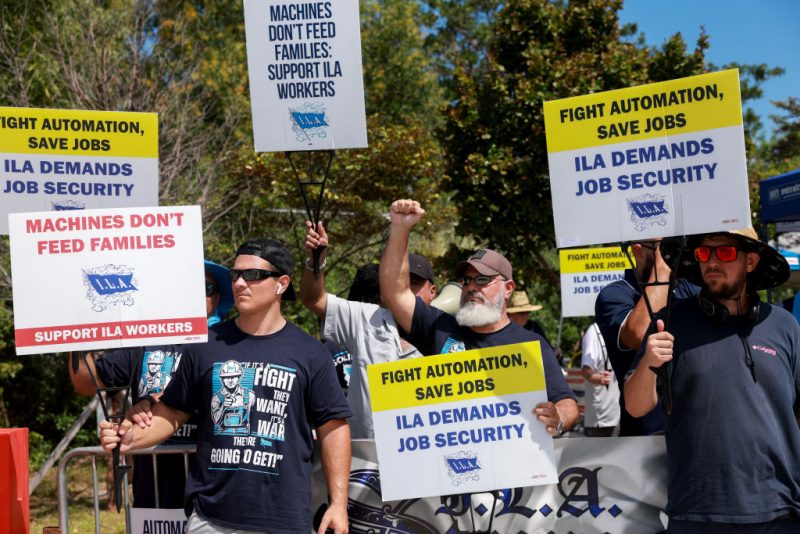

OAN Staff James Meyers
2:26 PM – Thursday, October 3, 2024
At least 45 container vessels were anchored outside U.S. ports on Thursday as a massive strike by dockworkers stretching from Maine all the way to Texas entered its third day.
Advertisement
Container ships continued to be backed up along the East Coast and Gulf Coast ports on Wednesday evening, being unable to unload goods due to picketing dockworkers, according to Everstream Analytics.
Prior to the strike on Sunday, only three container ships were anchored.
The outlet also expects the backup to double by the end of the week if strikes persist, and that the logjam could take months to clear.
“Many seem to have decided to wait it out, possibly in hopes of a prompt resolution to the strike action, rather than taking the proactive decision to divert,” Everstream’s Jean Santoro said in a video presentation seen by Reuters.
Meanwhile, over 45,000 port workers have demanded higher wages and additional protections in their next contract.
Analysts warn that the strike could cost the economy billions of dollars a day, as essential products such as food, automobiles, car parts, pharmaceuticals, and other goods shipments stall.
“I think we’re making progress,” President Joe Biden claimed on Thursday. “We’ll find out soon!”
However, there were still no negotiations scheduled on Thursday between the International Longshoremen’s Association and employers. Nevertheless, port owners issued a statement late on Wednesday indicating that they were open to new discussions.
“Reaching an agreement will require negotiating,” the United States Maritime Alliance said late Wednesday. “We cannot agree to preconditions to return to bargaining, but we remain committed to bargaining in good faith to address the ILA’s demands and USMX’s concerns.”
Harold Daggett, the union boss leading the strike, personally made $728,000 last year from the ILA. He stated that the union is looking for a $5 per hour raise for each year of the six-year contract, and a promise to prohibit automation.
Companies who have been negatively affected are hoping that Biden would impose the federal Taft-Hartley Act, which gives U.S. presidents the power to force employees to return to work for an 80-day cooling-off period during labor disputes.
However, those hopes went down the drain when Biden said on Monday that he does not “believe” in Taft-Hartley.
On Wednesday, the National Retail Federation and almost 300 other trade associations called on the Biden administration to take a firmer stance on the massive strike and to force employees back to work.
Yet, Daggett is still pushing back, asserting that the ILA is in it for the long haul.
“We are prepared to fight as long as necessary, to stay out on strike for whatever period of time it takes, to get the wages and protections against automation our ILA members deserve,” Daggett said on Tuesday.
Furthermore, the strike comes after the tragic Hurricane Helene caused massive destruction across the Southeastern states, ahead of the holiday season.
About half of U.S. imports arrive via water and on these container ships, according to Morgan Stanley.
The strike will not “immediately” affect prices, but the backups at the ports could lead to major shortages and price hikes.
“From a consumer standpoint if the strike goes a couple of weeks, you’ll start to see impacts on the grocery side,” Larry Gross, a supply chain analyst and president of Gross Transportation Consulting said, according to the New York Post.
Stay informed! Receive breaking news blasts directly to your inbox for free. Subscribe here. https://www.oann.com/alerts
Advertisements below






Be the first to comment